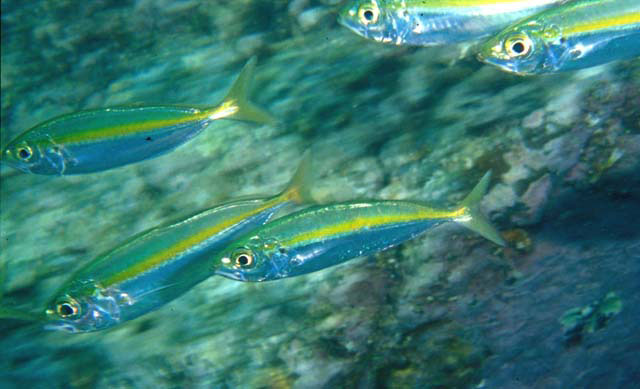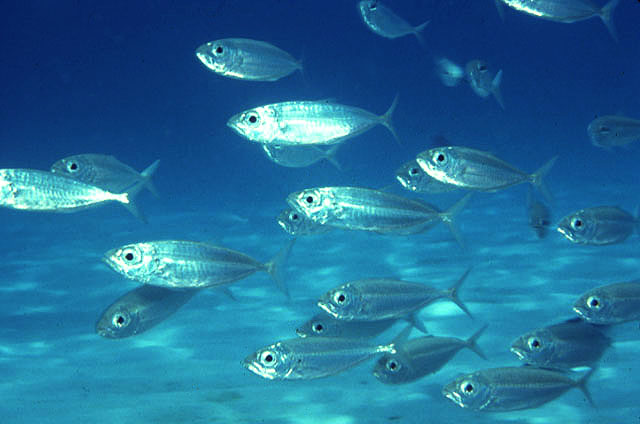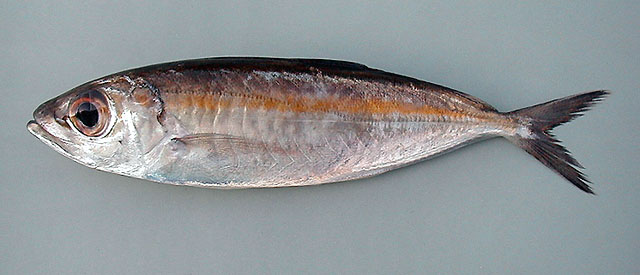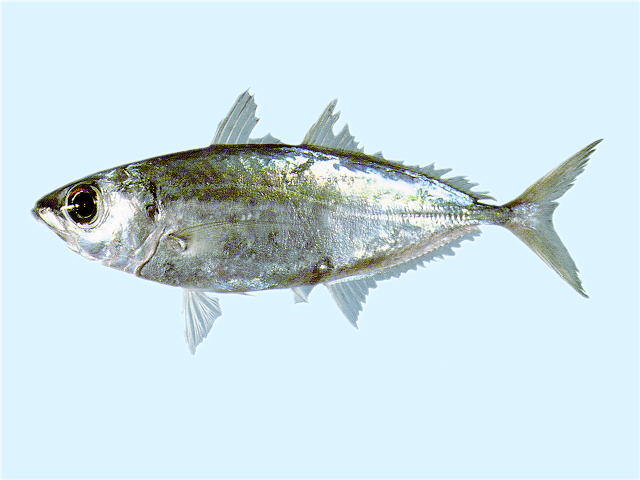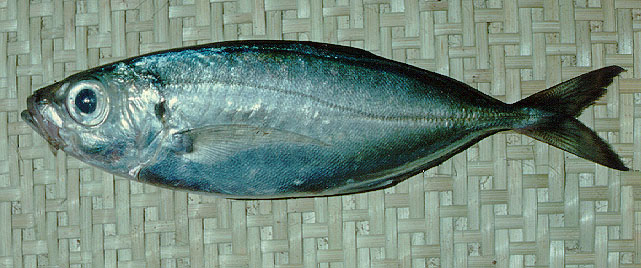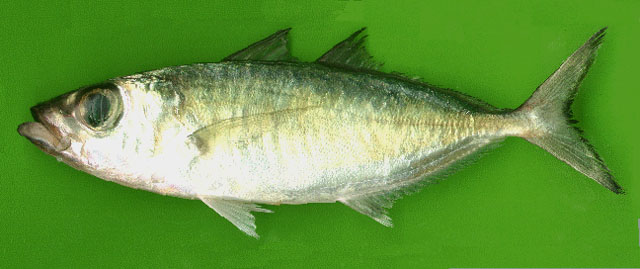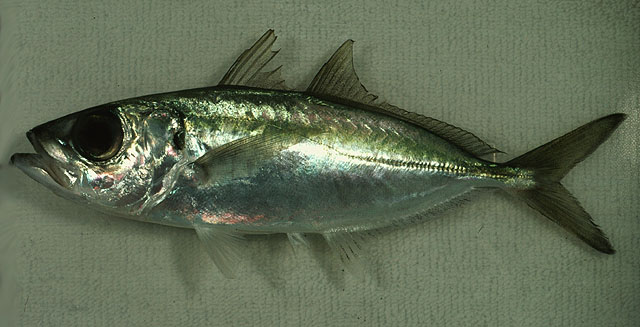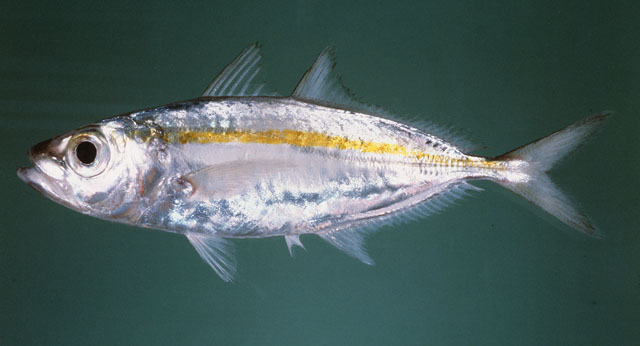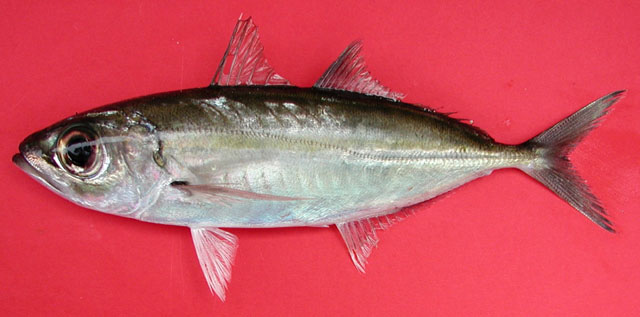Selar
crumenophthalmus
(Bloch,
1793)
Bigeye scad
View all media / Upload your photos and videos
Expand all
Classification / Names
Teleostei (teleosts) > Carangiformes (Jacks) >
Carangidae (Jacks and pompanos)
> Caranginae
Etymology: Selar: A Malay vernacular name, ikan selar
More on author:
Bloch.
Environment / milieu / depth range / climate zone / distribution range
Distribution
Circumtropical. Indo-Pacific: East Africa (Ref. 3287) to Rapa, north to southern Japan and the Hawaiian Islands, south to New Caledonia. Eastern Pacific: Mexico to Peru, including the Galapagos Islands (Ref. 5530). Western Atlantic: Nova Scotia, Canada and Bermuda through the Gulf of Mexico and the Caribbean to to São Paulo (Ref. 47377), Brazil. Eastern Atlantic: Cape Verde to southern Angola (Ref. 7097).
Maps

Selar crumenophthalmus / Native range
AquaMaps Data sources:
GBIF
OBIS
This map was computer-generated and has not yet been reviewed.

Selar crumenophthalmus / Suitable habitat
AquaMaps Data sources:
GBIF
OBIS
This map was computer-generated and has not yet been reviewed.

Selar crumenophthalmus / Point map
AquaMaps Data sources:
GBIF
OBIS
This map was computer-generated and has not yet been reviewed.

Selar crumenophthalmus / Year 2050
AquaMaps Data sources:
GBIF
OBIS
This map was computer-generated and has not yet been reviewed.
Length at first maturity / Size / Weight / Age
Short description
Dorsal spines (total): 9; Dorsal soft rays (total): 24 - 27; Anal spines: 3; Anal soft rays: 21 - 23. Description: Dorsal very blue-green or metallic blue, ventral silver or white; stripe (may be absent) yellow from gill opening upper end to caudal peduncle upper part; opercle edge with black spot. Body elongate and compressed moderately; profile, dorsal less convex than ventral. Eyes very large, shorter than snout length; adipose eyelid very well developed, covers the eye almost entirely. LL curved part equal or slightly shorter than straight part 0.7 to 1.3 times; LL scales 48-56 on curved part, 0-11 on straight part; LL scutes 29 to 42, small. Cleithrum with furrow, deep, ventral; large papilla immediately about furrow, small papilla near dorsal edge. Pectoral fins falcate; anal fins first two spines detached. (Ref. 2334, 55763, 90102)
Biology
Adults prefer clear oceanic waters around islands to neritic waters (Ref. 5217). Occasionally in turbid waters (Ref. 9283). Pelagic (Ref. 58302). Individuals travel in compact groups of hundreds of thousands of fish. Mainly nocturnal in habit, they disperse at night to feed on small shrimps, benthic invertebrates, and forams when inshore, and zooplankton and fish larvae when offshore (Ref. 9283, 90102). Marketed fresh and salted or dried (Ref. 9283). Reported to reach 70 cm TL (Ref. 48635).
Main reference
Smith-Vaniz, W.F. 1995 Carangidae. Jureles, pámpanos, cojinúas, zapateros, cocineros, casabes, macarelas, chicharros, jorobados, medregales, pez pilota. p. 940-986. In W. Fischer, F. Krupp, W. Schneider, C. Sommer, K.E. Carpenter and V. Niem (eds.) Guia FAO para Identification de Especies para lo Fines de la Pesca. Pacifico Centro-Oriental. 3 Vols. FAO, Rome. (Ref. 9283)
IUCN Red List Status (Ref. 125652)
Least Concern (LC); date assessed: November 07 2013
CITES (Ref. 131153)
Not Evaluated
CMS (Ref. 116361)
Not Evaluated
Threat to humans
Reports of ciguatera poisoning (Ref. 30911)
Human uses
Fisheries: highly commercial; gamefish: yes; bait: usually.
FAO - Fisheries: landings, species profile; Publication: search | FIRMS - Stock assessments | FishSource | Sea Around Us
More information
- Countries
- FAO areas
- Ecosystems
- Occurrences
- Introductions
- Stocks
- Ecology
- Diet
- Food items
- Food consumption
- Ration
- Common names
- Synonyms
- Metabolism
- Predators
- Ecotoxicology
- Reproduction
- Maturity
- Spawning
- Spawning aggregation
- Fecundity
- Eggs
- Egg development
- Age/Size
- Growth
- Length-weight
- Length-length
- Length-frequencies
- Morphometrics
- Morphology
- Larvae
- Larval dynamics
- Recruitment
- Abundance
- References
- Aquaculture
- Aquaculture profile
- Strains
- Genetics
- Allele frequencies
- Heritability
- Diseases
- Processing
- Mass conversion
- Vision
- Pictures
- Stamps, Coins Misc.
- Sounds
- Ciguatera
- Speed
- Swim. type
- Gill area
- Otoliths
- Brains
Estimates based on models
Preferred temperature (Ref. 123201): 20 - 29.2, mean 27.9 °C (based on 6848 cells).
Phylogenetic diversity index (Ref. 82804): PD50 = 0.75 [Uniqueness, from 0.5 = low to 2.0 = high].
Bayesian length-weight: a=0.01349 (0.01211 - 0.01503), b=2.99 (2.96 - 3.02), in cm total length, based on LWR estimates for this species (Ref. 93245).
Trophic level (Ref. 69278): 3.8 ±0.2 se; Based on diet studies.
Generation time: 1.0 ( na - na) years. Estimated as median ln(3)/K based on 1 growth studies.
Resilience (Ref. 120179): High, minimum population doubling time less than 15 months (K=0.6-0.9).
Prior r = 1.19, 95% CL = 0.79 - 1.79, Based on 8 data-limited stock assessments.
Fishing vulnerability (Ref. 59153): Low vulnerability (25 of 100).
Climate vulnerability (Ref. 125649): High vulnerability (60 of 100).
Price category (Ref. 80766): Very high; Reliable: based on ex-vessel price for this species.
Nutrients (Ref. 124155): Calcium = 44.7 [14.5, 96.7] mg/100g; Iron = 0.976 [0.355, 2.254] mg/100g; Protein = 21.2 [19.1, 23.1] %; Omega3 = 0.331 [0.165, 0.686] g/100g; Selenium = 51.7 [18.8, 141.0] μg/100g; VitaminA = 15.1 [3.9, 70.2] μg/100g; Zinc = 0.678 [0.337, 1.145] mg/100g (wet weight); based on nutrient studies.

